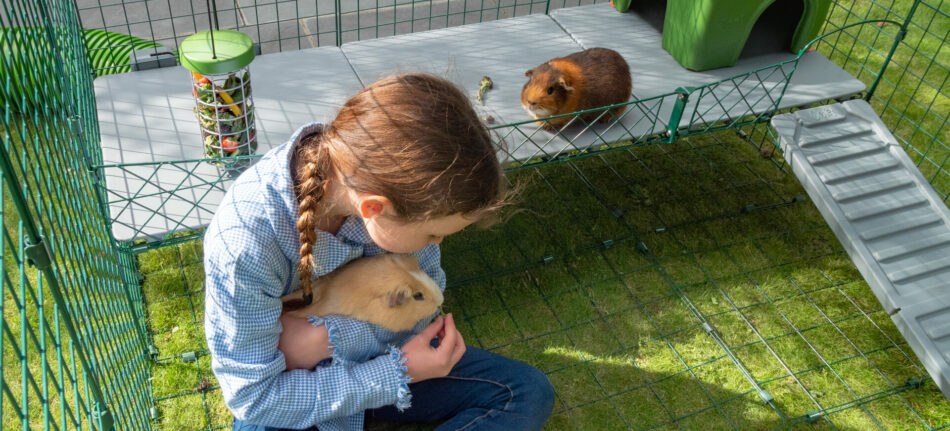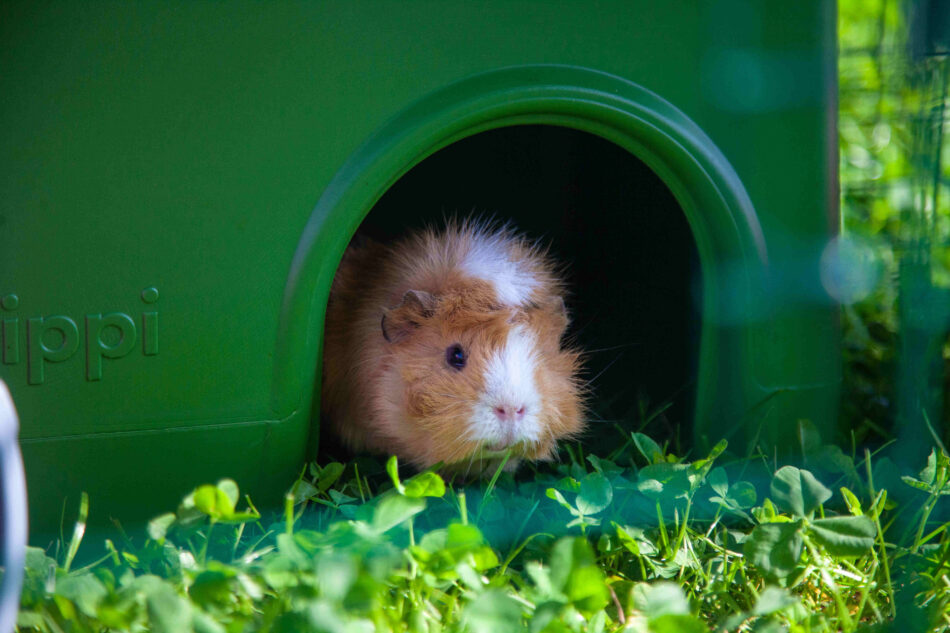How to understand the language of guinea pigs
Guinea pigs are popular small pets — great with children, adorable, and relatively easy to care for. But what many new guinea pig owners don’t know is that cavies make a wide range of sounds and movements to communicate with each other. Knowing how to understand the language of guinea pigs will help you determine how your cavies are feeling, and what messages they’re trying to convey to you.
Positive sounds
Positive sounds are your guinea pig expressing that they’re happy or relaxed. Cavies that are housed in safe and comfortable guinea pig hutches will frequently emit these noises in their home, or while being gently handled or played with by their owners.
Chutting: Sometimes referred to as a “clucking” sound similar to those made by a mother hen, this is a sound of guinea pig contentment. Your cavy may make this sound toward you during your interactions, or directed at their hutch-mates while spending time together. You may also hear this sound while your guinea pig tours their environment.
Cooing: This sound is one of affection and acknowledgement. Your guinea pig may coo at you out of recognition, or may coo at their guinea pig friends. Cooing is also common among female guinea pigs and their young.
Purring (low-pitched): Guinea pigs who feel comfortable will make a deep purring sound while being petted or held. This cat-like sound is often accompanied by a calm, relaxed posture from your guinea pig. While not as constant or intense as a cat’s purr, purring in cavies is a sign of ultimate contentment.
Wheeking: This sound is a distinctive and common vocalization made by guinea pigs, most often used to communicate excitement — especially when anticipating a treat or meal. Wheeking sounds like a loud squeal or whistle, and can be long or short and repetitive in a wheek-wheek-wheek pattern.
Negative sounds
Negative sounds from guinea pigs can express many different emotions. From fear to sadness, these noises are most often heard when a guinea pig is experiencing something uncomfortable or painful.
Teeth chattering: This is an aggressive volcalization that expresses anger or agitation. Most often directed at a hutch-mate, teeth chattering noises are usually accompanied by a show of teeth. This motion resembles a yawn, and is an indication that the chattering guinea pig is ready to attack.
Purring (high-pitched): A high-pitched purr is indicative of annoyance or uncertainty. This sound is different from a guinea pig’s contented purr, and sounds like a forceful vibration. A short, high-pitched purr usually means that your guinea pig is fearful of something.
Hissing: Like a cat, your guinea pig may hiss when feeling threatened or provoked. This is another display of aggression that precedes a cavy attacking the source of agitation.
Shrieking or squealing: These high-pitched, piercing noises are cries of alarm. Shrieking or squealing is usually in response to being bitten or bullied by another guinea pig, or in situations of intense fear.
Whining: This moaning type of squeak signals annoyance or dislike for something being done. This could be directed at you or another guinea pig, but isn’t usually a sign of aggression.
Chirping: Chirping is perhaps the least noticed and understood noise that guinea pigs make. This sound is made when cavies are taken away from their family. A chirping guinea pig may also appear to be in a trancelike state.
Positive body language
Positive body language in guinea pigs is used to express joy or pleasure during an activity. These activities may be playing in their guinea pig run, spending time with you, eating, or sleeping. The next time you watch or play with your guinea pig, keep an eye out for these expressions of a cavy living their best lives.
Popcorning: This gesture is one of the most iconic motions that guinea pigs are known for. Popcorning is when a guinea pig hops straight up into the air, sometimes repeatedly, while running. This literal jump for joy is entertaining and adorable for owners to behold.
Licking: If your guinea pig licks you, take it as a compliment. This sign of affection is usually reserved for grooming between two guinea pigs, but it’s not uncommon for cavies to “groom” their owners — or lick the salt from their skin.
Sprawling out: This extended pose is a show of trust and contentedness. Your guinea pig may lay with their front or back legs extended out, or sometimes both. Guinea pigs that stretch out in this way feel safe enough to assume this vulnerable position.
Negative body language
Take note of any negative body language from your guinea pigs. Like their negative vocalizations, these postures can be a warning of aggressive behaviors or injuries in your guinea pigs.
Backing away: If you’re trying to pick up your guinea pig and they back away, it’s a sign that they feel threatened and uncomfortable. As prey animals, their instinct is to flee from potential danger. Always approach your guinea pig slowly and wait to see their reaction before picking them up.
Fidgeting or biting while being held: Sometimes fidgeting while being held can be a sign that your guinea pig needs to relieve themselves. But it can also indicate that your guinea pig is scared, uncomfortable, or stressed. If your guinea pig bites, they’re most definitely scared or stressed.
Freezing: A startled guinea pig will freeze, standing motionless while they assess their surroundings. This nervous reaction is an effort to camouflage their presence and to take a moment to sniff and listen for danger.
Strutting: Moving side to side on stiff legs can be seen as an act of dominance or aggression. This stance is usually accompanied by teeth chattering.
Tossing the head: This behavior is most often seen in guinea pigs while being petted or about to be picked up. It’s a display of displeasure or annoyance, and may be their nicest way of informing you that they are done being doted on.
Standing on rear legs: Standing up on two legs is not a common posture for guinea pigs. It’s a sign that an attack is imminent. If new guinea pigs are being introduced to each other than this posture is observed, it’s important to separate them right away before a fight ensues.
Neutral communication
These sounds and behaviors are just part of life for guinea pigs, and don’t carry any real significance. You can expect to see or hear these actions and noises from healthy guinea pigs.
Mounting: This can be a sexual behavior between a male and female guinea pig, or used to assert dominance among the guinea pig herd — especially between females.
Scent marking: Guinea pigs will rub their chins, cheeks, and hind quarters on things they want to mark as theirs. They may also urinate on things or other guinea pigs to show their dominance.
Sniffing: Sniffing is a way to check out what is going on in the world around them, or when meeting new cavies. Guinea pigs particularly like to sniff each other around the nose, chin, ears, and back side to get acquainted.
Raising heads: This is usually a display of dominance over hutch-mates. Guinea pigs will stick their noses in the air, or lift their chins in an effort to assert their dominance.
Rumbling: A guinea pig rumble is deeper than a purr. This sound is usually heard when a male is courting a female as part of the mating ritual.
Running away when being picked up: Guinea pigs are prey animals, so they can be timid — especially when they’re new to your home. Running away when being picked up is a natural behavior that they’ll eventually overcome when you’re patient with them.
Concerning behaviors
Behaviors that are not part of normal guinea pig language should not be ignored. The following actions or noises warrant a call to the vet:
- Wheezing
- Excessive whining or squealing
- Limping
- Increased time spent sleeping or napping
- Circling or head tilting
Omlet and your guinea pigs
Learning the language of your guinea pigs will strengthen your bond and give you a deeper understanding of their nature. And when you house them in comfortable guinea pig hutches and guinea pig runs, you’ll be able to witness their most endearing behaviors — but most importantly, you’ll give them the safety and freedom they need to exhibit them. Top off their setup with Zippi Guinea Pig Tunnels for ultimate fun and burrowing, and your cavies will be popcorning and purring for years to come.
This entry was posted in Guinea Pigs



One reply on “How to understand the language of guinea pigs”
Very cute & sweet thank you this helps